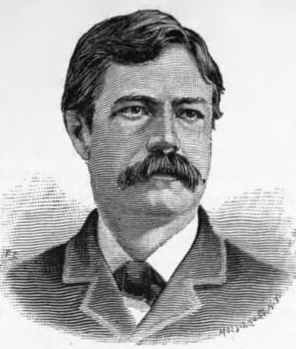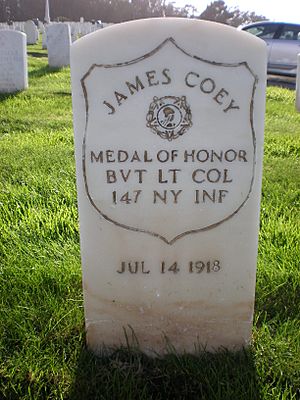James Coey facts for kids
Quick facts for kids
James Coey
|
|
|---|---|
 |
|
| Born | February 12, 1841 New York City, New York |
| Died | July 14, 1918 (aged 77) Berkeley, California |
| Buried | |
| Allegiance | |
| Service/ |
|
| Years of service | 1862 – 1865 |
| Rank | Brevet Lieutenant Colonel |
| Unit | |
| Battles/wars | American Civil War |
| Awards | |
James Coey (February 12, 1841 – July 14, 1918) was a brave United States Army officer. He fought for the Union Army during the American Civil War. He was part of the 147th New York Volunteer Infantry Regiment.
Coey earned the Medal of Honor, America's highest award for bravery. He received it for his actions at the Battle of Hatcher's Run in 1865. He rallied his troops and led a charge against the enemy.
After the war, James Coey held many important government jobs. He worked as a Postmaster in San Francisco and became a Major-General in the California National Guard.
Contents
Early Life and Education
James Coey was born in New York City, New York on February 12, 1841. His mother, Elizabeth Coey, was from Ireland. He grew up in New York with his two brothers, William John and Samuel.
Serving in the Civil War
James Coey joined the army when he was 21 years old. He enlisted in Oswego County, New York in August 1862. He officially became a soldier with the 147th New York Volunteer Infantry Regiment in September.
He quickly rose through the ranks. In October 1862, he became a first lieutenant. By February 1863, he was promoted to captain. For a short time in 1863, he worked at the Union's military prison in Elmira, New York.
Bravery in Battle
Coey showed great courage during the war. On May 7, 1864, he was badly wounded at the Battle of the Wilderness. This battle took place at Laurel Hill, Virginia. Because of his bravery, he was promoted to major in December 1864.
On February 6, 1865, he was wounded again at the Battle of Hatcher's Run. Despite his injuries, he grabbed his regiment's flag. He urged his fellow soldiers to charge the Confederate army. Even after being wounded, he ordered his men to help him onto his horse. He continued to lead his brigade to stop the enemy's advance.
For his actions, he received the Medal of Honor. He was also promoted to lieutenant colonel and then colonel for his outstanding service. He was in command of his regiment during the last year of the war. He left the army in June 1865.
After the war, records showed he had a gunshot wound to his face. This injury caused him to lose hearing in his right ear. It also led to facial paralysis and loss of his sense of smell.
Life After the War
After leaving the military, James Coey returned to New York. He lived in Redfield with his mother and brothers. He worked as an accountant.
Around 1866, James Coey married Maria L. Reynolds. They moved to California. He began a career in public service.
Important Government Roles
Coey held many important government positions in California:
- In 1868, he became the U.S. Collector of Internal Revenue for San Francisco.
- From 1869 to 1870, he served as the U.S. Postmaster for San Francisco.
- In 1871, he was appointed U.S. Assessor for the Internal Revenue Service in Utah Territory.
- In 1873, he became the Appraiser of Merchandise for San Francisco.
- He served as San Francisco's Postmaster again from 1874 to 1878, and from 1878 to 1882.
He also served in the California National Guard. In 1875, he became a brigadier-general. Later that year, he was promoted to major-general, commanding the entire California National Guard.
James Coey and his wife had two daughters, Louise and Emily. He was also active in politics and with the Grand Army of the Republic (G.A.R.). The G.A.R. was a group for Union Civil War veterans. He helped organize the G.A.R. in California and held several leadership roles.
Later in life, Coey shifted from public service to the mining industry.
Death and Burial
James Coey passed away at his home in Berkeley, California on July 14, 1918. He was 77 years old. After his funeral, he was buried with military honors at the San Francisco National Cemetery. His wife, Maria, was buried beside him after her death in 1925.


